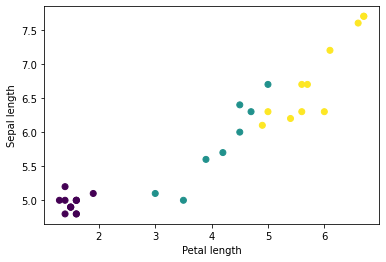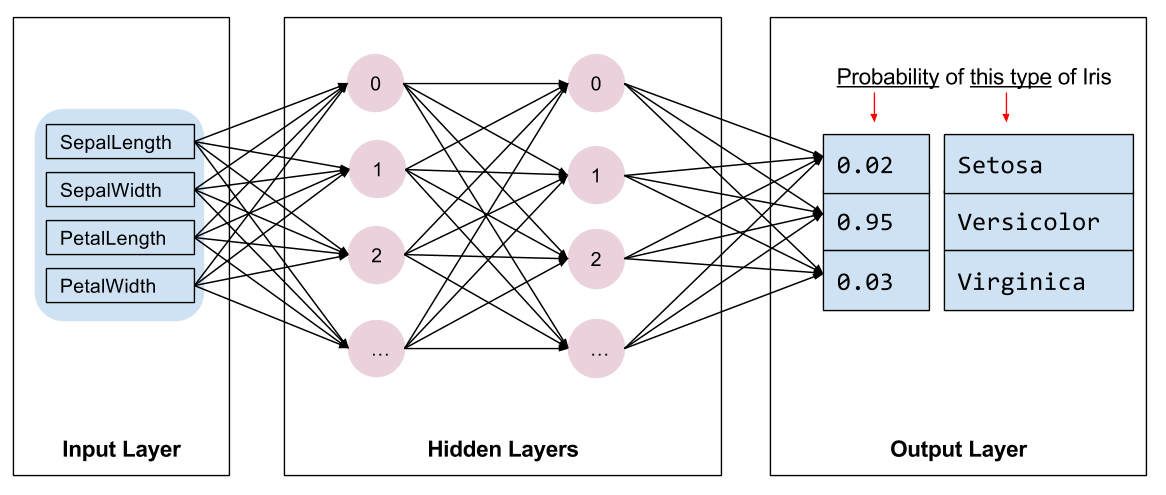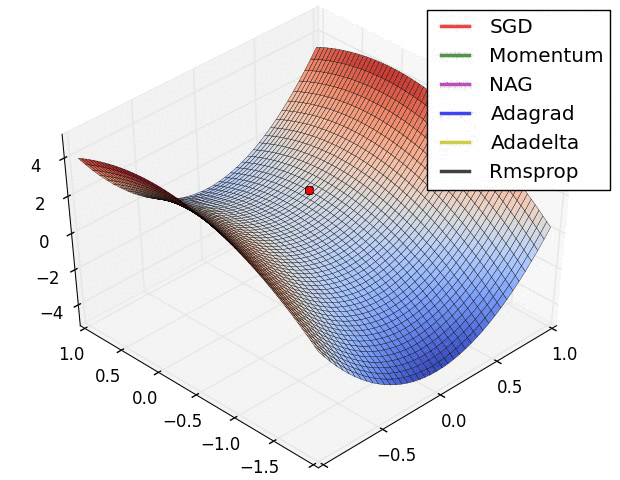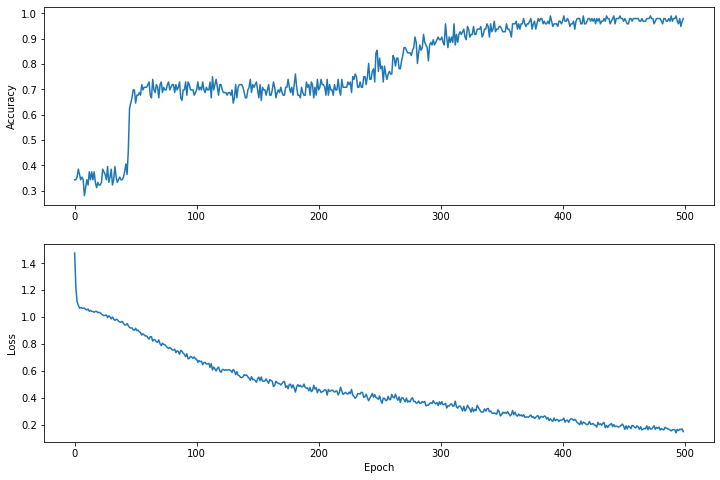 View on TensorFlow.org View on TensorFlow.org
|
 Run in Google Colab Run in Google Colab
|
 View source on GitHub View source on GitHub
|
This guide introduces Swift for TensorFlow by building a machine learning model that categorizes iris flowers by species. It uses Swift for TensorFlow to:
- Build a model,
- Train this model on example data, and
- Use the model to make predictions about unknown data.
TensorFlow programming
This guide uses these high-level Swift for TensorFlow concepts:
- Import data with the Epochs API.
- Build models using Swift abstractions.
- Use Python libraries using Swift's Python interoperability when pure Swift libraries are not available.
This tutorial is structured like many TensorFlow programs:
- Import and parse the data sets.
- Select the type of model.
- Train the model.
- Evaluate the model's effectiveness.
- Use the trained model to make predictions.
Setup program
Configure imports
Import TensorFlow and some useful Python modules.
import TensorFlow
import PythonKit
// This cell is here to display the plots in a Jupyter Notebook.
// Do not copy it into another environment.
%include "EnableIPythonDisplay.swift"
print(IPythonDisplay.shell.enable_matplotlib("inline"))
('inline', 'module://ipykernel.pylab.backend_inline')
let plt = Python.import("matplotlib.pyplot")
import Foundation
import FoundationNetworking
func download(from sourceString: String, to destinationString: String) {
let source = URL(string: sourceString)!
let destination = URL(fileURLWithPath: destinationString)
let data = try! Data.init(contentsOf: source)
try! data.write(to: destination)
}
The iris classification problem
Imagine you are a botanist seeking an automated way to categorize each iris flower you find. Machine learning provides many algorithms to classify flowers statistically. For instance, a sophisticated machine learning program could classify flowers based on photographs. Our ambitions are more modest—we're going to classify iris flowers based on the length and width measurements of their sepals and petals.
The Iris genus entails about 300 species, but our program will only classify the following three:
- Iris setosa
- Iris virginica
- Iris versicolor

|
|
Figure 1. Iris setosa (by Radomil, CC BY-SA 3.0), Iris versicolor, (by Dlanglois, CC BY-SA 3.0), and Iris virginica (by Frank Mayfield, CC BY-SA 2.0). |
Fortunately, someone has already created a data set of 120 iris flowers with the sepal and petal measurements. This is a classic dataset that is popular for beginner machine learning classification problems.
Import and parse the training dataset
Download the dataset file and convert it into a structure that can be used by this Swift program.
Download the dataset
Download the training dataset file from http://download.tensorflow.org/data/iris_training.csv
let trainDataFilename = "iris_training.csv"
download(from: "http://download.tensorflow.org/data/iris_training.csv", to: trainDataFilename)
Inspect the data
This dataset, iris_training.csv, is a plain text file that stores tabular data formatted as comma-separated values (CSV). Let's look a the first 5 entries.
let f = Python.open(trainDataFilename)
for _ in 0..<5 {
print(Python.next(f).strip())
}
print(f.close())
120,4,setosa,versicolor,virginica 6.4,2.8,5.6,2.2,2 5.0,2.3,3.3,1.0,1 4.9,2.5,4.5,1.7,2 4.9,3.1,1.5,0.1,0 None
From this view of the dataset, notice the following:
- The first line is a header containing information about the dataset:
- There are 120 total examples. Each example has four features and one of three possible label names.
- Subsequent rows are data records, one example per line, where:
- The first four fields are features: these are characteristics of an example. Here, the fields hold float numbers representing flower measurements.
- The last column is the label: this is the value we want to predict. For this dataset, it's an integer value of 0, 1, or 2 that corresponds to a flower name.
Let's write that out in code:
let featureNames = ["sepal_length", "sepal_width", "petal_length", "petal_width"]
let labelName = "species"
let columnNames = featureNames + [labelName]
print("Features: \(featureNames)")
print("Label: \(labelName)")
Features: ["sepal_length", "sepal_width", "petal_length", "petal_width"] Label: species
Each label is associated with string name (for example, "setosa"), but machine learning typically relies on numeric values. The label numbers are mapped to a named representation, such as:
0: Iris setosa1: Iris versicolor2: Iris virginica
For more information about features and labels, see the ML Terminology section of the Machine Learning Crash Course.
let classNames = ["Iris setosa", "Iris versicolor", "Iris virginica"]
Create a dataset using the Epochs API
Swift for TensorFlow's Epochs API is a high-level API for reading data and transforming it into a form used for training.
let batchSize = 32
/// A batch of examples from the iris dataset.
struct IrisBatch {
/// [batchSize, featureCount] tensor of features.
let features: Tensor<Float>
/// [batchSize] tensor of labels.
let labels: Tensor<Int32>
}
/// Conform `IrisBatch` to `Collatable` so that we can load it into a `TrainingEpoch`.
extension IrisBatch: Collatable {
public init<BatchSamples: Collection>(collating samples: BatchSamples)
where BatchSamples.Element == Self {
/// `IrisBatch`es are collated by stacking their feature and label tensors
/// along the batch axis to produce a single feature and label tensor
features = Tensor<Float>(stacking: samples.map{$0.features})
labels = Tensor<Int32>(stacking: samples.map{$0.labels})
}
}
Since the datasets we downloaded are in CSV format, let's write a function to load in the data as a list of IrisBatch objects
/// Initialize an `IrisBatch` dataset from a CSV file.
func loadIrisDatasetFromCSV(
contentsOf: String, hasHeader: Bool, featureColumns: [Int], labelColumns: [Int]) -> [IrisBatch] {
let np = Python.import("numpy")
let featuresNp = np.loadtxt(
contentsOf,
delimiter: ",",
skiprows: hasHeader ? 1 : 0,
usecols: featureColumns,
dtype: Float.numpyScalarTypes.first!)
guard let featuresTensor = Tensor<Float>(numpy: featuresNp) else {
// This should never happen, because we construct featuresNp in such a
// way that it should be convertible to tensor.
fatalError("np.loadtxt result can't be converted to Tensor")
}
let labelsNp = np.loadtxt(
contentsOf,
delimiter: ",",
skiprows: hasHeader ? 1 : 0,
usecols: labelColumns,
dtype: Int32.numpyScalarTypes.first!)
guard let labelsTensor = Tensor<Int32>(numpy: labelsNp) else {
// This should never happen, because we construct labelsNp in such a
// way that it should be convertible to tensor.
fatalError("np.loadtxt result can't be converted to Tensor")
}
return zip(featuresTensor.unstacked(), labelsTensor.unstacked()).map{IrisBatch(features: $0.0, labels: $0.1)}
}
We can now use the CSV loading function to load the training dataset and create a TrainingEpochs object
let trainingDataset: [IrisBatch] = loadIrisDatasetFromCSV(contentsOf: trainDataFilename,
hasHeader: true,
featureColumns: [0, 1, 2, 3],
labelColumns: [4])
let trainingEpochs: TrainingEpochs = TrainingEpochs(samples: trainingDataset, batchSize: batchSize)
The TrainingEpochs object is an infinite sequence of epochs. Each epoch contains IrisBatches. Let's look at the first element of the first epoch.
let firstTrainEpoch = trainingEpochs.next()!
let firstTrainBatch = firstTrainEpoch.first!.collated
let firstTrainFeatures = firstTrainBatch.features
let firstTrainLabels = firstTrainBatch.labels
print("First batch of features: \(firstTrainFeatures)")
print("firstTrainFeatures.shape: \(firstTrainFeatures.shape)")
print("First batch of labels: \(firstTrainLabels)")
print("firstTrainLabels.shape: \(firstTrainLabels.shape)")
First batch of features: [[5.1, 2.5, 3.0, 1.1], [6.4, 3.2, 4.5, 1.5], [4.9, 3.1, 1.5, 0.1], [5.0, 2.0, 3.5, 1.0], [6.3, 2.5, 5.0, 1.9], [6.7, 3.1, 5.6, 2.4], [4.9, 3.1, 1.5, 0.1], [7.7, 2.8, 6.7, 2.0], [6.7, 3.0, 5.0, 1.7], [7.2, 3.6, 6.1, 2.5], [4.8, 3.0, 1.4, 0.1], [5.2, 3.4, 1.4, 0.2], [5.0, 3.5, 1.3, 0.3], [4.9, 3.1, 1.5, 0.1], [5.0, 3.5, 1.6, 0.6], [6.7, 3.3, 5.7, 2.1], [7.7, 3.8, 6.7, 2.2], [6.2, 3.4, 5.4, 2.3], [4.8, 3.4, 1.6, 0.2], [6.0, 2.9, 4.5, 1.5], [5.0, 3.0, 1.6, 0.2], [6.3, 3.4, 5.6, 2.4], [5.1, 3.8, 1.9, 0.4], [4.8, 3.1, 1.6, 0.2], [7.6, 3.0, 6.6, 2.1], [5.7, 3.0, 4.2, 1.2], [6.3, 3.3, 6.0, 2.5], [5.6, 2.5, 3.9, 1.1], [5.0, 3.4, 1.6, 0.4], [6.1, 3.0, 4.9, 1.8], [5.0, 3.3, 1.4, 0.2], [6.3, 3.3, 4.7, 1.6]] firstTrainFeatures.shape: [32, 4] First batch of labels: [1, 1, 0, 1, 2, 2, 0, 2, 1, 2, 0, 0, 0, 0, 0, 2, 2, 2, 0, 1, 0, 2, 0, 0, 2, 1, 2, 1, 0, 2, 0, 1] firstTrainLabels.shape: [32]
Notice that the features for the first batchSize examples are grouped together (or batched) into firstTrainFeatures, and that the labels for the first batchSize examples are batched into firstTrainLabels.
You can start to see some clusters by plotting a few features from the batch, using Python's matplotlib:
let firstTrainFeaturesTransposed = firstTrainFeatures.transposed()
let petalLengths = firstTrainFeaturesTransposed[2].scalars
let sepalLengths = firstTrainFeaturesTransposed[0].scalars
plt.scatter(petalLengths, sepalLengths, c: firstTrainLabels.array.scalars)
plt.xlabel("Petal length")
plt.ylabel("Sepal length")
plt.show()

Use `print()` to show values.
Select the type of model
Why model?
A model is a relationship between features and the label. For the iris classification problem, the model defines the relationship between the sepal and petal measurements and the predicted iris species. Some simple models can be described with a few lines of algebra, but complex machine learning models have a large number of parameters that are difficult to summarize.
Could you determine the relationship between the four features and the iris species without using machine learning? That is, could you use traditional programming techniques (for example, a lot of conditional statements) to create a model? Perhaps—if you analyzed the dataset long enough to determine the relationships between petal and sepal measurements to a particular species. And this becomes difficult—maybe impossible—on more complicated datasets. A good machine learning approach determines the model for you. If you feed enough representative examples into the right machine learning model type, the program will figure out the relationships for you.
Select the model
We need to select the kind of model to train. There are many types of models and picking a good one takes experience. This tutorial uses a neural network to solve the iris classification problem. Neural networks can find complex relationships between features and the label. It is a highly-structured graph, organized into one or more hidden layers. Each hidden layer consists of one or more neurons. There are several categories of neural networks and this program uses a dense, or fully-connected neural network: the neurons in one layer receive input connections from every neuron in the previous layer. For example, Figure 2 illustrates a dense neural network consisting of an input layer, two hidden layers, and an output layer:

|
|
Figure 2. A neural network with features, hidden layers, and predictions. |
When the model from Figure 2 is trained and fed an unlabeled example, it yields three predictions: the likelihood that this flower is the given iris species. This prediction is called inference. For this example, the sum of the output predictions is 1.0. In Figure 2, this prediction breaks down as: 0.02 for Iris setosa, 0.95 for Iris versicolor, and 0.03 for Iris virginica. This means that the model predicts—with 95% probability—that an unlabeled example flower is an Iris versicolor.
Create a model using the Swift for TensorFlow Deep Learning Library
The Swift for TensorFlow Deep Learning Library defines primitive layers and conventions for wiring them together, which makes it easy to build models and experiment.
A model is a struct that conforms to Layer, which means that it defines a callAsFunction(_:) method that maps input Tensors to output Tensors. The callAsFunction(_:) method often simply sequences the input through sublayers. Let's define an IrisModel that sequences the input through three Dense sublayers.
import TensorFlow
let hiddenSize: Int = 10
struct IrisModel: Layer {
var layer1 = Dense<Float>(inputSize: 4, outputSize: hiddenSize, activation: relu)
var layer2 = Dense<Float>(inputSize: hiddenSize, outputSize: hiddenSize, activation: relu)
var layer3 = Dense<Float>(inputSize: hiddenSize, outputSize: 3)
@differentiable
func callAsFunction(_ input: Tensor<Float>) -> Tensor<Float> {
return input.sequenced(through: layer1, layer2, layer3)
}
}
var model = IrisModel()
The activation function determines the output shape of each node in the layer. These non-linearities are important—without them the model would be equivalent to a single layer. There are many available activations, but ReLU is common for hidden layers.
The ideal number of hidden layers and neurons depends on the problem and the dataset. Like many aspects of machine learning, picking the best shape of the neural network requires a mixture of knowledge and experimentation. As a rule of thumb, increasing the number of hidden layers and neurons typically creates a more powerful model, which requires more data to train effectively.
Using the model
Let's have a quick look at what this model does to a batch of features:
// Apply the model to a batch of features.
let firstTrainPredictions = model(firstTrainFeatures)
print(firstTrainPredictions[0..<5])
[[ 1.1514063, -0.7520321, -0.6730235], [ 1.4915676, -0.9158071, -0.9957161], [ 1.0549936, -0.7799266, -0.410466], [ 1.1725322, -0.69009197, -0.8345413], [ 1.4870572, -0.8644099, -1.0958937]]
Here, each example returns a logit for each class.
To convert these logits to a probability for each class, use the softmax function:
print(softmax(firstTrainPredictions[0..<5]))
[[ 0.7631462, 0.11375094, 0.123102814], [ 0.8523791, 0.076757915, 0.07086295], [ 0.7191151, 0.11478964, 0.16609532], [ 0.77540654, 0.12039323, 0.10420021], [ 0.8541314, 0.08133837, 0.064530246]]
Taking the argmax across classes gives us the predicted class index. But, the model hasn't been trained yet, so these aren't good predictions.
print("Prediction: \(firstTrainPredictions.argmax(squeezingAxis: 1))")
print(" Labels: \(firstTrainLabels)")
Prediction: [0, 0, 0, 0, 0, 0, 0, 0, 0, 0, 0, 0, 0, 0, 0, 0, 0, 0, 0, 0, 0, 0, 0, 0, 0, 0, 0, 0, 0, 0, 0, 0]
Labels: [1, 1, 0, 1, 2, 2, 0, 2, 1, 2, 0, 0, 0, 0, 0, 2, 2, 2, 0, 1, 0, 2, 0, 0, 2, 1, 2, 1, 0, 2, 0, 1]
Train the model
Training is the stage of machine learning when the model is gradually optimized, or the model learns the dataset. The goal is to learn enough about the structure of the training dataset to make predictions about unseen data. If you learn too much about the training dataset, then the predictions only work for the data it has seen and will not be generalizable. This problem is called overfitting—it's like memorizing the answers instead of understanding how to solve a problem.
The iris classification problem is an example of supervised machine learning: the model is trained from examples that contain labels. In unsupervised machine learning, the examples don't contain labels. Instead, the model typically finds patterns among the features.
Choose a loss function
Both training and evaluation stages need to calculate the model's loss. This measures how off a model's predictions are from the desired label, in other words, how bad the model is performing. We want to minimize, or optimize, this value.
Our model will calculate its loss using the softmaxCrossEntropy(logits:labels:) function which takes the model's class probability predictions and the desired label, and returns the average loss across the examples.
Let's calculate the loss for the current untrained model:
let untrainedLogits = model(firstTrainFeatures)
let untrainedLoss = softmaxCrossEntropy(logits: untrainedLogits, labels: firstTrainLabels)
print("Loss test: \(untrainedLoss)")
Loss test: 1.7598655
Create an optimizer
An optimizer applies the computed gradients to the model's variables to minimize the loss function. You can think of the loss function as a curved surface (see Figure 3) and we want to find its lowest point by walking around. The gradients point in the direction of steepest ascent—so we'll travel the opposite way and move down the hill. By iteratively calculating the loss and gradient for each batch, we'll adjust the model during training. Gradually, the model will find the best combination of weights and bias to minimize loss. And the lower the loss, the better the model's predictions.

|
|
Figure 3. Optimization algorithms visualized over time in 3D space. (Source: Stanford class CS231n, MIT License, Image credit: Alec Radford) |
Swift for TensorFlow has many optimization algorithms available for training. This model uses the SGD optimizer that implements the stochastic gradient descent (SGD) algorithm. The learningRate sets the step size to take for each iteration down the hill. This is a hyperparameter that you'll commonly adjust to achieve better results.
let optimizer = SGD(for: model, learningRate: 0.01)
Let's use optimizer to take a single gradient descent step. First, we compute the gradient of the loss with respect to the model:
let (loss, grads) = valueWithGradient(at: model) { model -> Tensor<Float> in
let logits = model(firstTrainFeatures)
return softmaxCrossEntropy(logits: logits, labels: firstTrainLabels)
}
print("Current loss: \(loss)")
Current loss: 1.7598655
Next, we pass the gradient that we just calculated to the optimizer, which updates the model's differentiable variables accordingly:
optimizer.update(&model, along: grads)
If we calculate the loss again, it should be smaller, because gradient descent steps (usually) decrease the loss:
let logitsAfterOneStep = model(firstTrainFeatures)
let lossAfterOneStep = softmaxCrossEntropy(logits: logitsAfterOneStep, labels: firstTrainLabels)
print("Next loss: \(lossAfterOneStep)")
Next loss: 1.5318773
Training loop
With all the pieces in place, the model is ready for training! A training loop feeds the dataset examples into the model to help it make better predictions. The following code block sets up these training steps:
- Iterate over each epoch. An epoch is one pass through the dataset.
- Within an epoch, iterate over each batch in the training epoch
- Collate the batch and grab its features (
x) and label (y). - Using the collated batch's features, make a prediction and compare it with the label. Measure the inaccuracy of the prediction and use that to calculate the model's loss and gradients.
- Use gradient descent to update the model's variables.
- Keep track of some stats for visualization.
- Repeat for each epoch.
The epochCount variable is the number of times to loop over the dataset collection. Counter-intuitively, training a model longer does not guarantee a better model. epochCount is a hyperparameter that you can tune. Choosing the right number usually requires both experience and experimentation.
let epochCount = 500
var trainAccuracyResults: [Float] = []
var trainLossResults: [Float] = []
func accuracy(predictions: Tensor<Int32>, truths: Tensor<Int32>) -> Float {
return Tensor<Float>(predictions .== truths).mean().scalarized()
}
for (epochIndex, epoch) in trainingEpochs.prefix(epochCount).enumerated() {
var epochLoss: Float = 0
var epochAccuracy: Float = 0
var batchCount: Int = 0
for batchSamples in epoch {
let batch = batchSamples.collated
let (loss, grad) = valueWithGradient(at: model) { (model: IrisModel) -> Tensor<Float> in
let logits = model(batch.features)
return softmaxCrossEntropy(logits: logits, labels: batch.labels)
}
optimizer.update(&model, along: grad)
let logits = model(batch.features)
epochAccuracy += accuracy(predictions: logits.argmax(squeezingAxis: 1), truths: batch.labels)
epochLoss += loss.scalarized()
batchCount += 1
}
epochAccuracy /= Float(batchCount)
epochLoss /= Float(batchCount)
trainAccuracyResults.append(epochAccuracy)
trainLossResults.append(epochLoss)
if epochIndex % 50 == 0 {
print("Epoch \(epochIndex): Loss: \(epochLoss), Accuracy: \(epochAccuracy)")
}
}
Epoch 0: Loss: 1.475254, Accuracy: 0.34375 Epoch 50: Loss: 0.91668004, Accuracy: 0.6458333 Epoch 100: Loss: 0.68662673, Accuracy: 0.6979167 Epoch 150: Loss: 0.540665, Accuracy: 0.6979167 Epoch 200: Loss: 0.46283028, Accuracy: 0.6979167 Epoch 250: Loss: 0.4134724, Accuracy: 0.8229167 Epoch 300: Loss: 0.35054502, Accuracy: 0.8958333 Epoch 350: Loss: 0.2731444, Accuracy: 0.9375 Epoch 400: Loss: 0.23622067, Accuracy: 0.96875 Epoch 450: Loss: 0.18956228, Accuracy: 0.96875
Visualize the loss function over time
While it's helpful to print out the model's training progress, it's often more helpful to see this progress. We can create basic charts using Python's matplotlib module.
Interpreting these charts takes some experience, but you really want to see the loss go down and the accuracy go up.
plt.figure(figsize: [12, 8])
let accuracyAxes = plt.subplot(2, 1, 1)
accuracyAxes.set_ylabel("Accuracy")
accuracyAxes.plot(trainAccuracyResults)
let lossAxes = plt.subplot(2, 1, 2)
lossAxes.set_ylabel("Loss")
lossAxes.set_xlabel("Epoch")
lossAxes.plot(trainLossResults)
plt.show()

Use `print()` to show values.
Note that the y-axes of the graphs are not zero-based.
Evaluate the model's effectiveness
Now that the model is trained, we can get some statistics on its performance.
Evaluating means determining how effectively the model makes predictions. To determine the model's effectiveness at iris classification, pass some sepal and petal measurements to the model and ask the model to predict what iris species they represent. Then compare the model's prediction against the actual label. For example, a model that picked the correct species on half the input examples has an accuracy of 0.5. Figure 4 shows a slightly more effective model, getting 4 out of 5 predictions correct at 80% accuracy:
| Example features | Label | Model prediction | |||
|---|---|---|---|---|---|
| 5.9 | 3.0 | 4.3 | 1.5 | 1 | 1 |
| 6.9 | 3.1 | 5.4 | 2.1 | 2 | 2 |
| 5.1 | 3.3 | 1.7 | 0.5 | 0 | 0 |
| 6.0 | 3.4 | 4.5 | 1.6 | 1 | 2 |
| 5.5 | 2.5 | 4.0 | 1.3 | 1 | 1 |
|
Figure 4. An iris classifier that is 80% accurate. | |||||
Setup the test dataset
Evaluating the model is similar to training the model. The biggest difference is the examples come from a separate test set rather than the training set. To fairly assess a model's effectiveness, the examples used to evaluate a model must be different from the examples used to train the model.
The setup for the test dataset is similar to the setup for training dataset. Download the test set from http://download.tensorflow.org/data/iris_test.csv:
let testDataFilename = "iris_test.csv"
download(from: "http://download.tensorflow.org/data/iris_test.csv", to: testDataFilename)
Now load it into a an array of IrisBatches:
let testDataset = loadIrisDatasetFromCSV(
contentsOf: testDataFilename, hasHeader: true,
featureColumns: [0, 1, 2, 3], labelColumns: [4]).inBatches(of: batchSize)
Evaluate the model on the test dataset
Unlike the training stage, the model only evaluates a single epoch of the test data. In the following code cell, we iterate over each example in the test set and compare the model's prediction against the actual label. This is used to measure the model's accuracy across the entire test set.
// NOTE: Only a single batch will run in the loop since the batchSize we're using is larger than the test set size
for batchSamples in testDataset {
let batch = batchSamples.collated
let logits = model(batch.features)
let predictions = logits.argmax(squeezingAxis: 1)
print("Test batch accuracy: \(accuracy(predictions: predictions, truths: batch.labels))")
}
Test batch accuracy: 0.96666664
We can see on the first batch, for example, the model is usually correct:
let firstTestBatch = testDataset.first!.collated
let firstTestBatchLogits = model(firstTestBatch.features)
let firstTestBatchPredictions = firstTestBatchLogits.argmax(squeezingAxis: 1)
print(firstTestBatchPredictions)
print(firstTestBatch.labels)
[1, 2, 0, 1, 1, 1, 0, 2, 1, 2, 2, 0, 2, 1, 1, 0, 1, 0, 0, 2, 0, 1, 2, 2, 1, 1, 0, 1, 2, 1] [1, 2, 0, 1, 1, 1, 0, 2, 1, 2, 2, 0, 2, 1, 1, 0, 1, 0, 0, 2, 0, 1, 2, 1, 1, 1, 0, 1, 2, 1]
Use the trained model to make predictions
We've trained a model and demonstrated that it's good—but not perfect—at classifying iris species. Now let's use the trained model to make some predictions on unlabeled examples; that is, on examples that contain features but not a label.
In real-life, the unlabeled examples could come from lots of different sources including apps, CSV files, and data feeds. For now, we're going to manually provide three unlabeled examples to predict their labels. Recall, the label numbers are mapped to a named representation as:
0: Iris setosa1: Iris versicolor2: Iris virginica
let unlabeledDataset: Tensor<Float> =
[[5.1, 3.3, 1.7, 0.5],
[5.9, 3.0, 4.2, 1.5],
[6.9, 3.1, 5.4, 2.1]]
let unlabeledDatasetPredictions = model(unlabeledDataset)
for i in 0..<unlabeledDatasetPredictions.shape[0] {
let logits = unlabeledDatasetPredictions[i]
let classIdx = logits.argmax().scalar!
print("Example \(i) prediction: \(classNames[Int(classIdx)]) (\(softmax(logits)))")
}
Example 0 prediction: Iris setosa ([ 0.98731947, 0.012679046, 1.4035809e-06]) Example 1 prediction: Iris versicolor ([0.005065103, 0.85957265, 0.13536224]) Example 2 prediction: Iris virginica ([2.9613977e-05, 0.2637373, 0.73623306])
